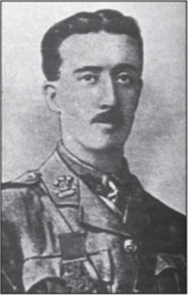John Vincent Holland
| John Vincent Holland | |
|---|---|
 | |
| Born |
19 July 1889 Athy, County Kildare, Ireland |
| Died |
27 February 1975 (aged 86) Hobart, Tasmania, Australia |
| Allegiance |
|
| Service/branch |
British Indian Army |
| Rank | Major |
| Unit | 3rd Battalion, Prince of Wales's Leinster Regiment |
| Battles/wars |
World War I World War II |
| Awards | Victoria Cross |
John Vincent Holland VC (19 July 1889 – 27 February 1975), was an Irish recipient of the Victoria Cross, the highest and most prestigious award for gallantry in the face of the enemy that can be awarded to British and Commonwealth forces.
Early life and education
Holland was born into a middle-class family in Athy, County Kildare, the son of veterinary surgeon John Holland and Catherine Peppard.[1] He was educated first at Clongowes Wood College and later at Liverpool University, and was one of 600 Old Clongovians to enlist in the army during World War One.[2]
World War One
He enlisted in 1914 in the 2nd Life Guards. In March 1915 he was attached to the 2nd Battalion of the Royal Dublin Fusiliers and sent to France. He was then wounded in August and returned to England and Ireland to convalesce, but soon returned to the battlefield—this time with the 7th Battalion, serving as battalion bombing officer.
On 3 September 1916 at Guillemont, France, he performed a deed for which he was awarded the Victoria Cross. The London Gazette stated that, "During a heavy engagement, Lieutenant Holland, not content with bombing hostile dug-outs, fearlessly led his troops through our own artillery barrage and cleared a great part of the village in front. He started out with 26 troops and finished with only five after capturing some 50 prisoners. By this gallant action he undoubtedly broke the spirit of the enemy and saved many casualties."[3]
Holland was also promoted to Captain, Mentioned in Dispatches and given the Hickie Parchment for his bravery.
Later life
In 1917, Holland married Frances Grogan at the cathedral in Cork City. Together they had two sons: Major Niall V. Holland (d. 1944), who was killed in Burma during the Second World War and Norman J. Holland.
In 1918, Holland was discharged from the army, but re-enlisted with the 9th Lancers of the Indian Army in November 1919 where he reached the rank of major. He also served for a period in Kenya. In 1922, he retired from the army and entered the civil service. At the outbreak of the Second World War, Holland again re-enlisted, joining the 9/10th D.C.O. Lancers (Hodson's Horse) but was invalided out in 1941. He then took up a position with the Ministry of Food.[4] In 1956, Holland and his wife emigrated to Hobart, Tasmania. Frances Holland died there in 1960; John Holland survived to see the birth of his first great-grandchild before dying in February 1975. He was buried in Cornelian Bay Cemetery, Hobart, with full military honours.
On 3 September 2009, a memorial plaque at Guillemont Church was unveiled, dedicated to the memory of the three soldiers who won VCs at Guillemont: John Vincent Holland, Thomas Hughes, and David Jones.[5]
References
- ↑ "John Vincent Holland V.C.". Retrieved 5 July 2016.
- ↑ "Remembering the War Dead". Jesuits in Ireland. Retrieved 5 July 2016.
- ↑ The London Gazette: (Supplement) no. 29802. p. 10394. 26 October 1916. Retrieved 10 April 2015.
- ↑ "John Vincent Holland V.C.". Retrieved 5 July 2016.
- ↑ Gliddon, Gerald. VCs of the First World War: Somme 1916.
External links
- John Vincent Holland VC 1889-1975 (Brief biography and details of town hall presentation)